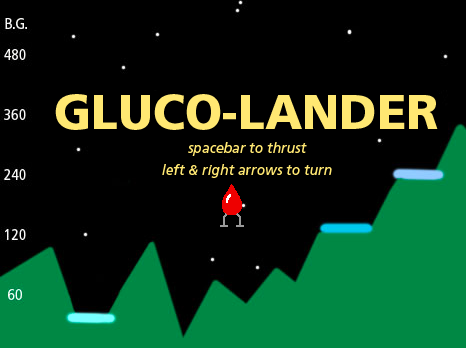Gluco-lander
Origin story: When my son Andrew was diagnosed with type 1 diabetes, we all had a lot to learn. Around that time, we also learned about Scratch, the programming language for kids developed by MIT. Both of us are big video game fans, so we decided to see if we could make a diabetes video game. We did, and as far as we can tell, there are only a handful out there.
My son Andrew and I wanted to make a game that taught a little about diabetes, but was mostly just fun to play. Gluco-lander is a game based on the classic Lunar Lander, except that it uses blood sugar management to control and land the ship. There are multiple levels, and even two mini-games that start if your blood sugar is too high or too low. You might learn something, but most of all, you should have fun playing (and we didn't make it too easy)!
Blood sugar management concepts you will learn in the game:
Type 1 diabetes is obviously way more complicated than that, but we think Gluco-lander serves as a basic introduction to understanding three main ideas that 1) blood sugar levels need to be checked, 2) if they are too high or too low you need to take action, and 3) what actions you typically take in each situation.
Clear five levels and you win!
Blood sugar management concepts you will learn in the game:
- Landing on the 120 blood glucose landing pad gets you to the next level.
- Landing on the 40 blood glucose landing pad is too low, and launches a mini-game to correct it.
- Landing on the 240 high blood glucose landing pad is too high, and also launches a second mini-game to correct it.
- In the low sugar mini-game, you have to eat 2 glucose tablets to raise your blood sugar. Then you go back to the main game.
- In the high sugar mini-game, you have to inject yourself with insulin to lower your blood sugar. Then you go back to the main game.
Type 1 diabetes is obviously way more complicated than that, but we think Gluco-lander serves as a basic introduction to understanding three main ideas that 1) blood sugar levels need to be checked, 2) if they are too high or too low you need to take action, and 3) what actions you typically take in each situation.
Clear five levels and you win!
